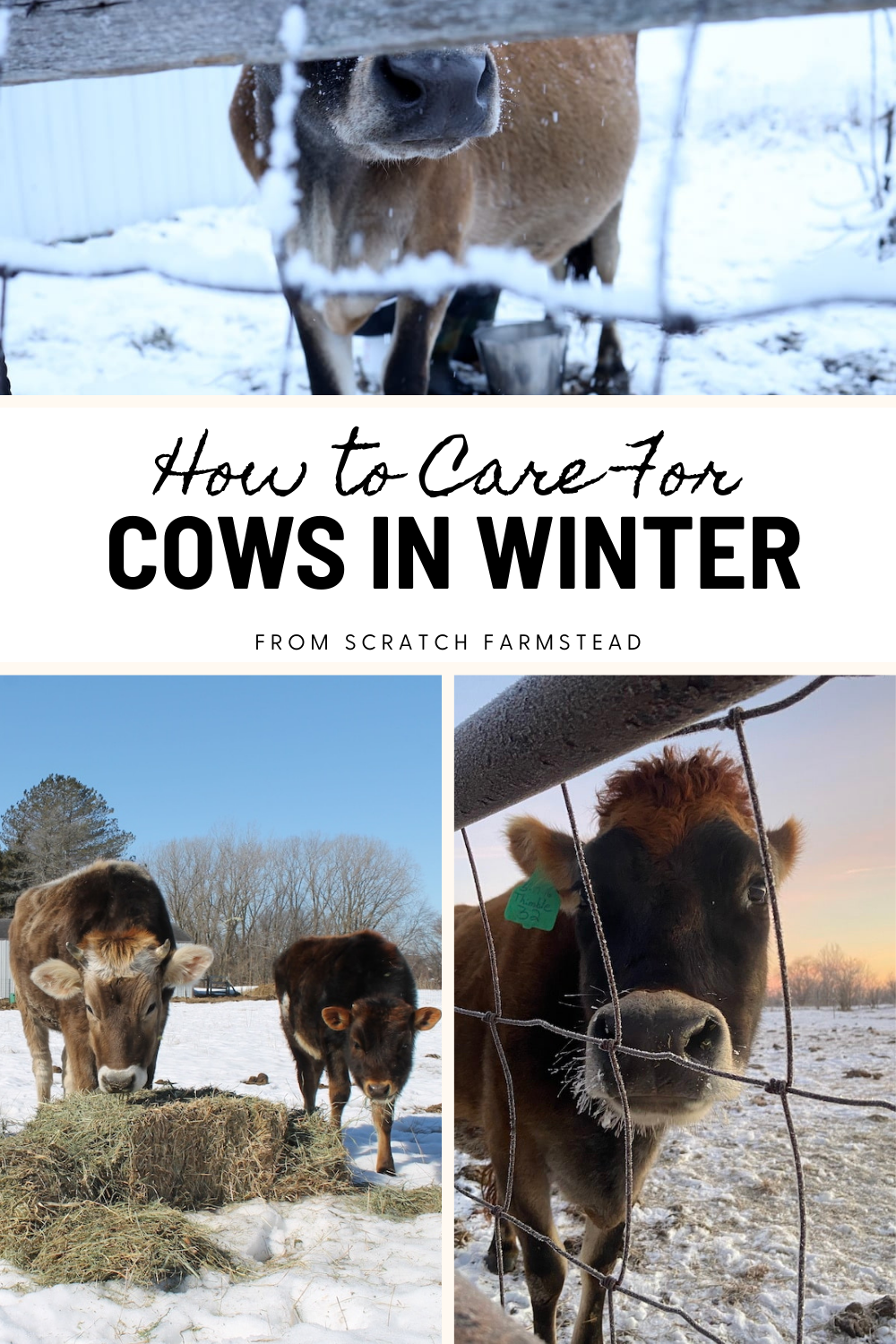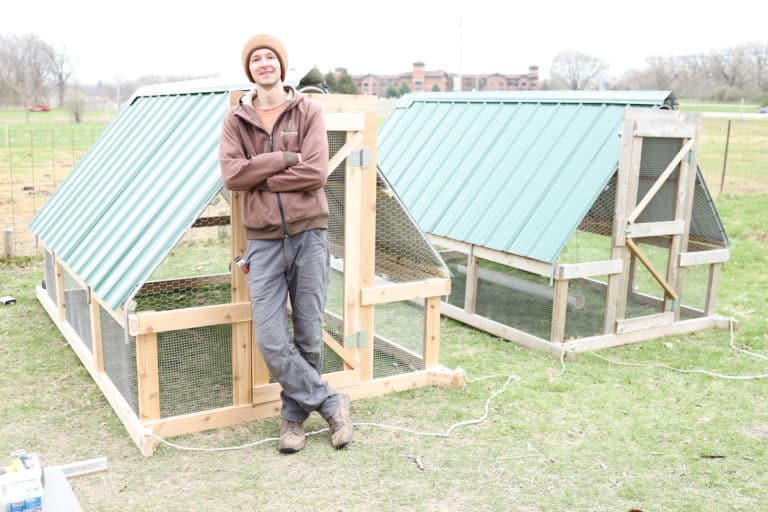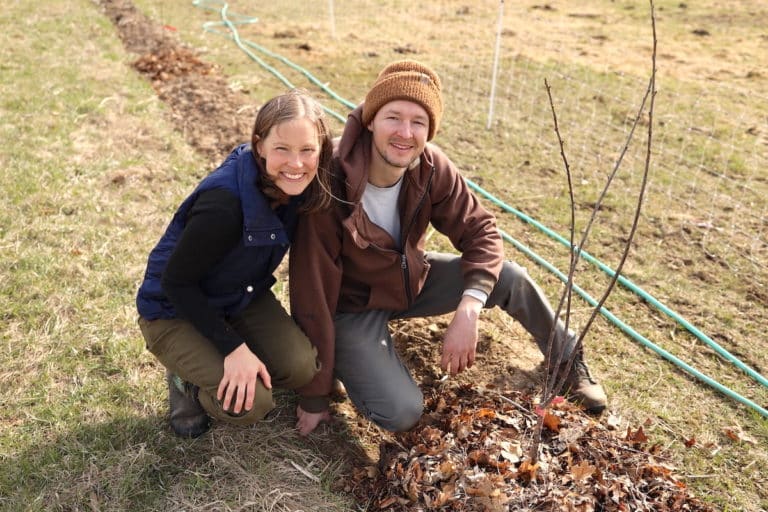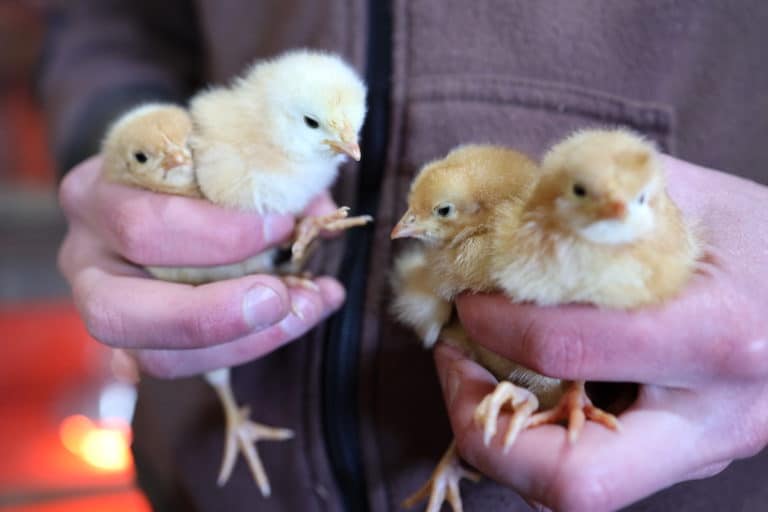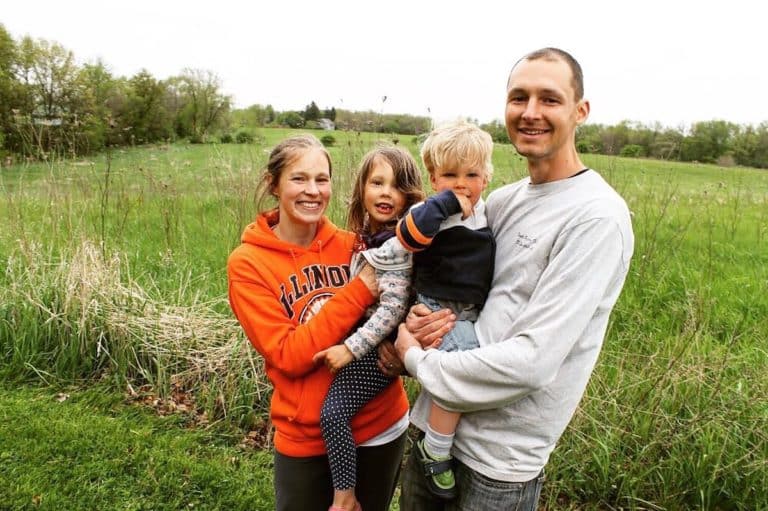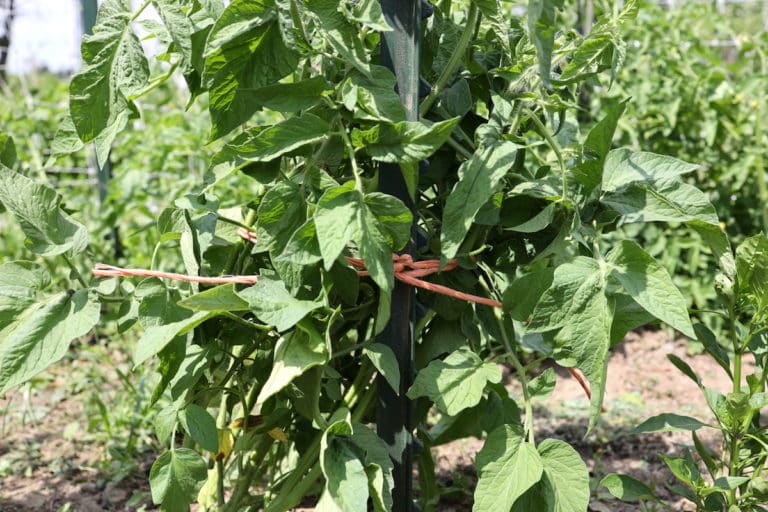Do Cows Get Cold? How To Keep Cows Warm in Winter
When our formerly suburban family bought a milk cow, the list of questions was a mile long! At the top of that list, “How in the world do we do this in the winter?” Since then we’ve learned a lot by visiting farms, working at farms, and keeping our own cows in the winter. So, do cows get cold? Let’s dig in and look at the basics of cold weather care.
Our Simple Winter Cow Setup
We keep a dairy cow and one or two of her calves on our 5 acre homestead in northern Illinois. With little previous experience, we learned a TON along the way. But this small herd has survived the last several winters just fine, even in the extreme cold temperatures that come in northern Illinois.
Our setup is nothing special! Cows are hardy animals and can handle low temperatures. Our cows are 100% grass-fed meaning they’re on pasture all growing season and fed hay through the cold months, providing them with plenty of extra energy to get them through the cold conditions. This increase in their feed intake is important to help the cows handle the colder temperatures.
This video shows more of our winter cow setup.
Even when eating hay in winter, the cows are outside in a fenced paddock. Our stall inside our pole barn is only reserved for the coldest stretches, or when they are wet and need a place to dry off.
With the right food, water, and shelter, keeping your cows warm and happy all winter long is 100% doable!
Do Cows Get Cold and What Can They Tolerate?
Cows are happiest in weather between 40-60°F. They will generally be comfortable with temperatures reaching down to 18-20°F. Below that range, cows can start to experience the stresses of their cold environment and require additional care and management. If their needs are met, cows can handle temperatures down to zero or below.
Cows are warm-blooded animals and keep a constant core body temperature around 101°F. Cows maintaining that body temperature will appear calm. If your cow exhibits behaviors like mooing excessively, devouring food aggressively and rapidly, or their milk supply or body weight is dropping, they might be in a stressed state from the cold.
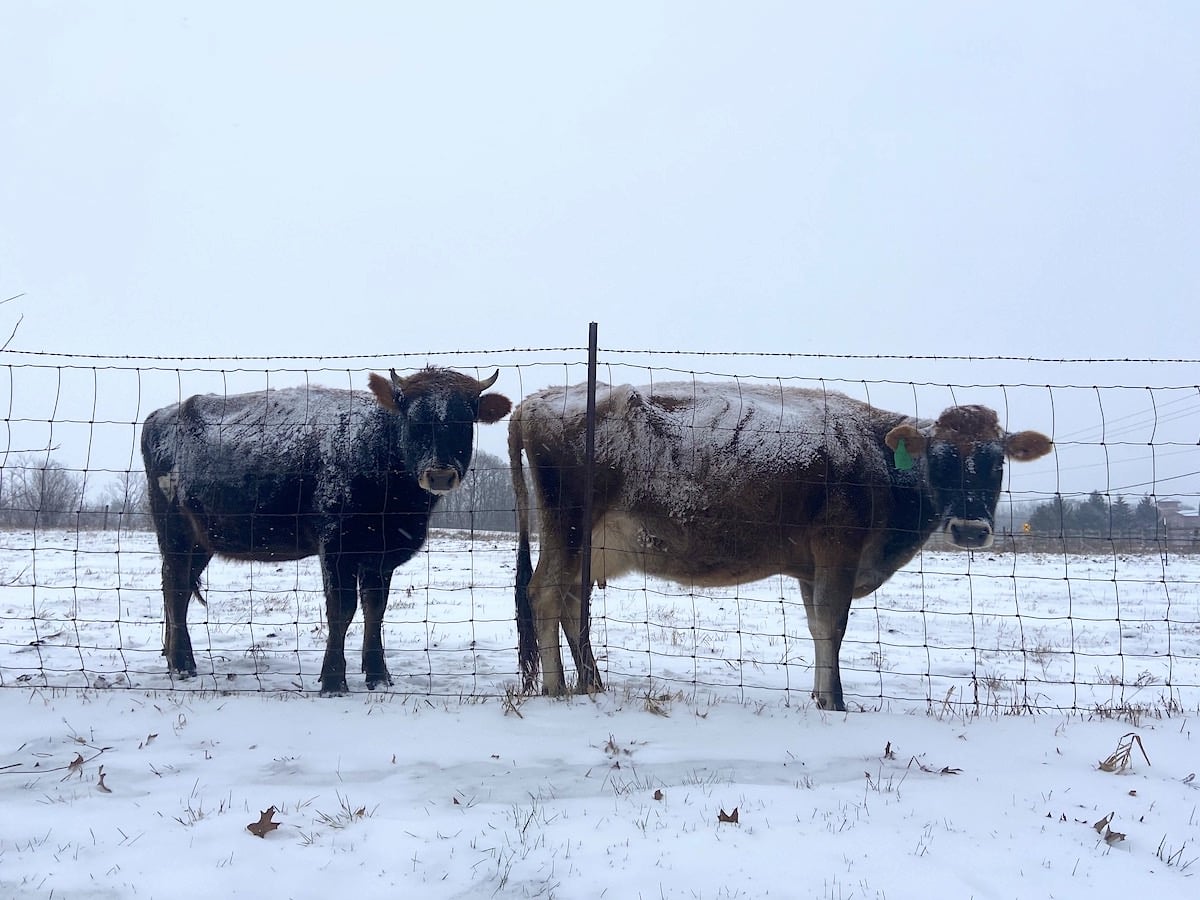
The biggest winter threat is when a cow’s coat of fur becomes wet followed by freezing temps. We’ll talk more about shelters below, but some access to a dry space without wind is a necessity. Without it, cows might not be able to dry off and bring their body temperatures back up on their own. Their body heat can only help them so much when you factor in cold wind and cold rain. Maintaining a dry winter coat is essential.
This is especially true with newborn or young calves. If a newborn calf is born in temperatures below 32°F, they will likely need to be brought into a barn or shelter to dry off and keep warm. Young calves should also be monitored closely and given access to dry shelter during their first few months. They aren’t able to moderate their constant core body temperature as well as an adult cow, and therefore are more sensitive to the cold temperatures and have not had the time to build up a sufficient winter coat.
That said, cows are built for the cold and capable of maintaining their own body temperatures to keep warm.
How do cows stay warm in the winter?
Cows have three ways to keep warm in the winter: growing winter hair, thick and fatty skin, and proper food intake.
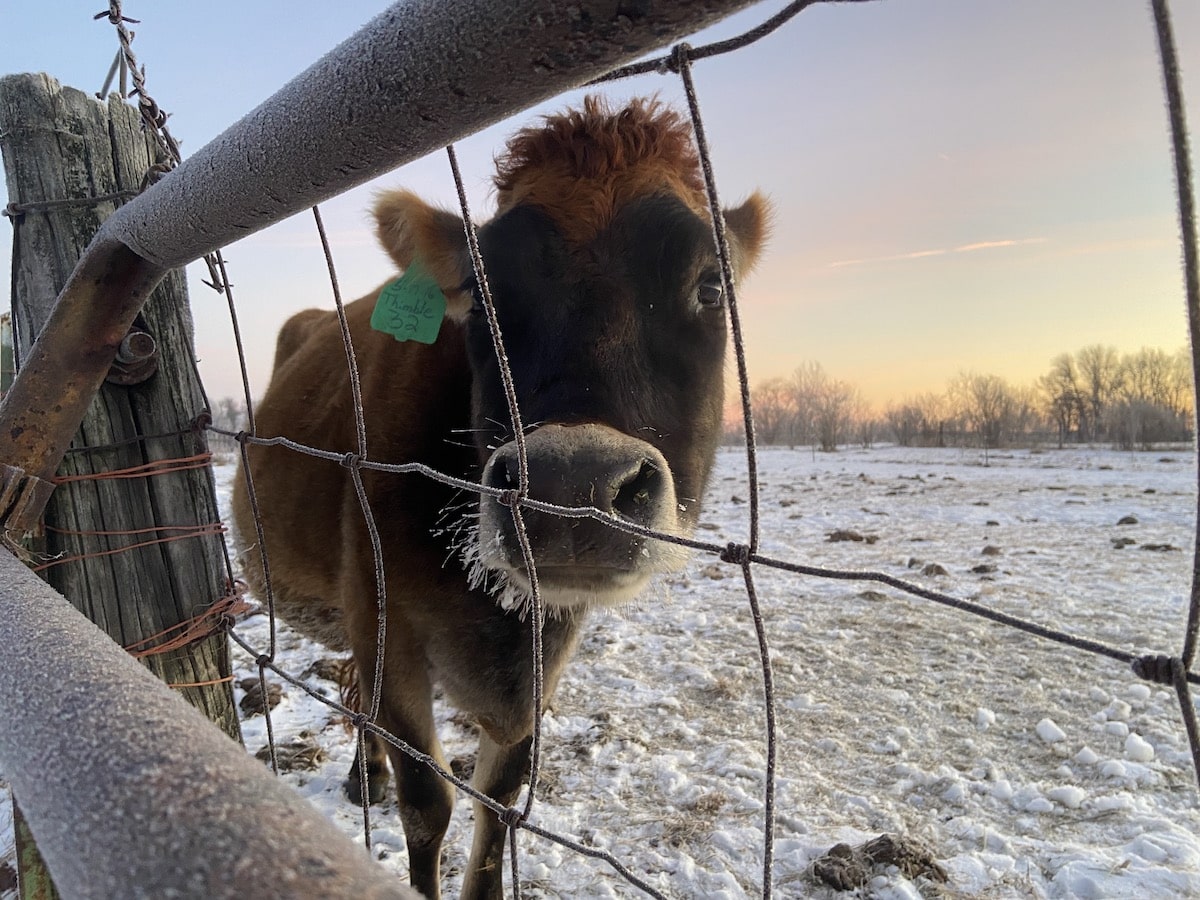
1. Growing Winter Hair
In the cool fall months, cows start to grow a thick hair coat. Their heavy winter coat makes an excellent outer layer to help trap body heat while shedding wind and other elements. However, this coat is not impermeable and can be dangerous when wet, causing cold stress on the cows. We like to keep close watch on the weather and make adjustments as needed. For instance, if sleet or cold rain is coming followed by rapidly dropping temperatures or a winter storm, this might be a time when we’d preemptively open up barn access for them.
2. Thick and Fatty Skin
A cow can also prepare for winter by bulking up and consuming additional feed. Cows naturally have thick skin, which helps keep cold out and heat in. But you may also notice their desire to prepare for the winter months by increasing their food intake and storing up extra fat under their skin. This extra feed will go beyond the daily maintenance energy requirements for adult cows and lead to good body conditions for your herd. This, combined with overall good nutrition will add yet another layer of protection from cold conditions.
3. Proper Food Intake
Cows are ruminants, meaning their stomachs are designed to digest and internally ferment grasses and other plants. Both of these processes—digestion and fermentation—naturally produce heat. This allows cows to heat themselves from the inside out if given enough food, which we’ll talk more about.
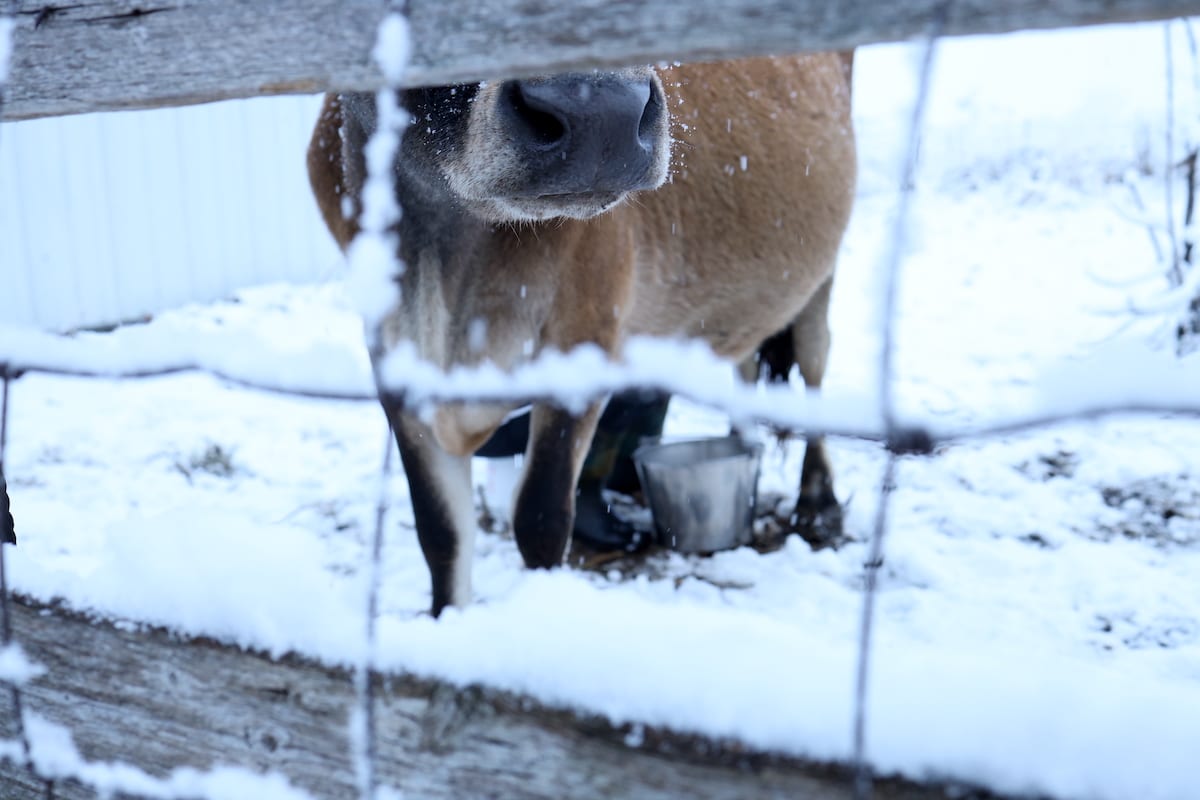
Does body condition matter?
The basic answer to this is yes, good body condition and a cow’s body condition score does matter to help cattle thrive in low temperatures. However, good body condition can include many variables including a cow’s breed, genetics, and unique bio-individual makeup.
An obvious example is that dairy cattle have a different build than beef cattle and tend to show more bone structure. Our Jersey milk cow, Thimble, often gets the label of ‘poor condition,’ when we know that she is getting good nutrition through higher-quality hay, fresh water, and adequate calorie intake. She just wears her weight differently than other adult cows. For that reason, we would say Thimble is in good condition and tend not to view body condition in a one-size-fits-all way.
Dairy Cows vs. Beef Cows in Winter
Dairy cows and beef cows don’t differ all that much. But because they’re bred for different functions, the cold temperatures do affect them in different ways.
Dairy Cows
Dairy cattle are not only expending energy to keep themselves warm but also to continue producing milk in the winter months. You might say they are pulling double duty. Some studies have shown a dairy cow will consume as much as 50% more during the winter months.
We have found it helpful to monitor our cow’s milk supply during the winter months to know if they are lacking anything in their diet and staying warm enough. A drop in supply may indicate they are expending the bulk of their energy to keep warm, therefore putting less energy toward milk production. Usually, this tells us they need more food, minerals, or access to shelter.
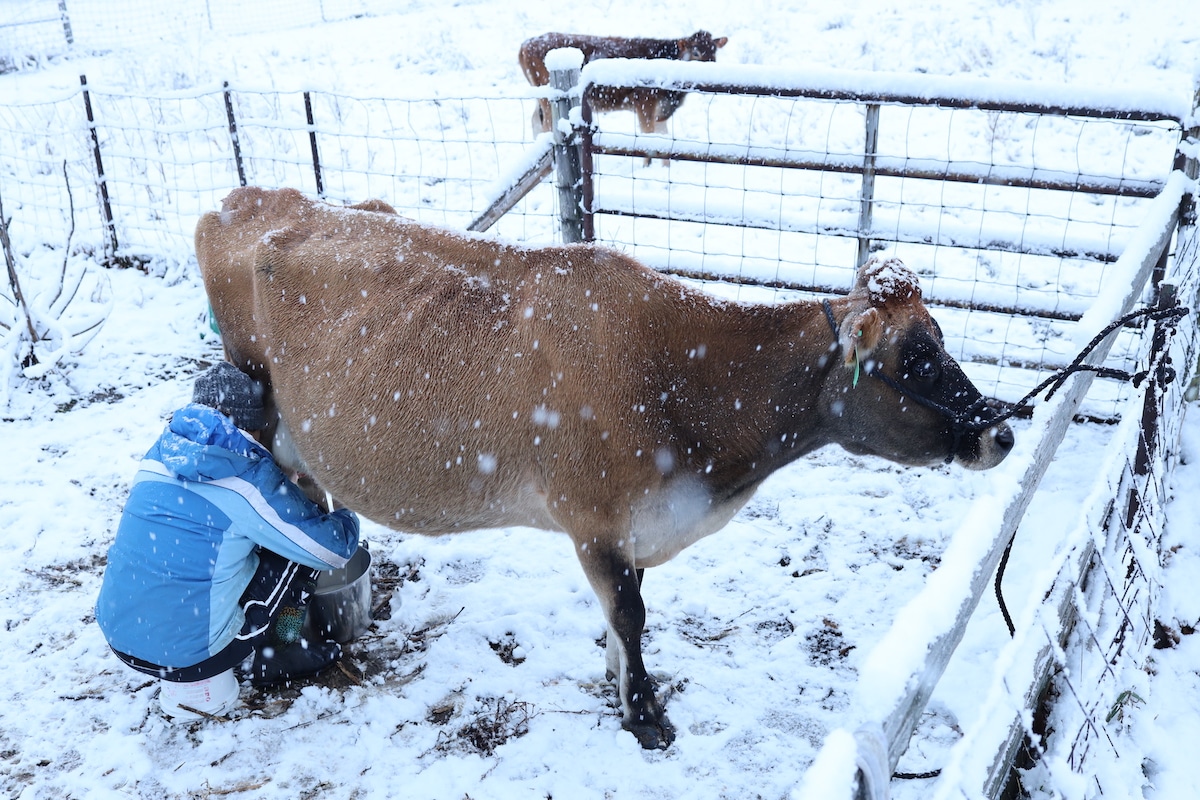
The udder and teats of dairy cows are particularly vulnerable during the winter months. If exposed to too much cold or wind, their teats especially will become chapped and crack. This causes a lot of discomfort and can make them rather agitated while milking.
When we experience wounds on teats from the cold with our milk cow we know it’s time to offer her more barn access to get her out of the wind. By applying some healing salve or balm to the wounds, being gentle during milking, and giving her a dry, wind-free shelter with extra straw, she’ll typically heal up within a couple days.
Beef Cows
Beef cattle will also have increased intake needs during the winter months. Though, typically, less so than a dairy cow who is also producing milk. A beef cow’s food consumption will go up around 20-25% during the winter months.
Beef cows are also generally hardier than dairy cows beacause of their larger frame and build. This allows them to keep their body heat up more easily in frigid temps with fewer needs and inputs.
What do cows eat in the winter?
Knowing that a cow’s feed intake will increase anywhere from 20-50% during the winter months, what then do you feed them?
Often, their diet looks similar to what it does the rest of the year. A cow typically on pasture will most likely transition to a diet of high-quality hay. Hay is a mixture of pasture grasses and plants that have been cut, cured, and preserved for consumption past the growing season.
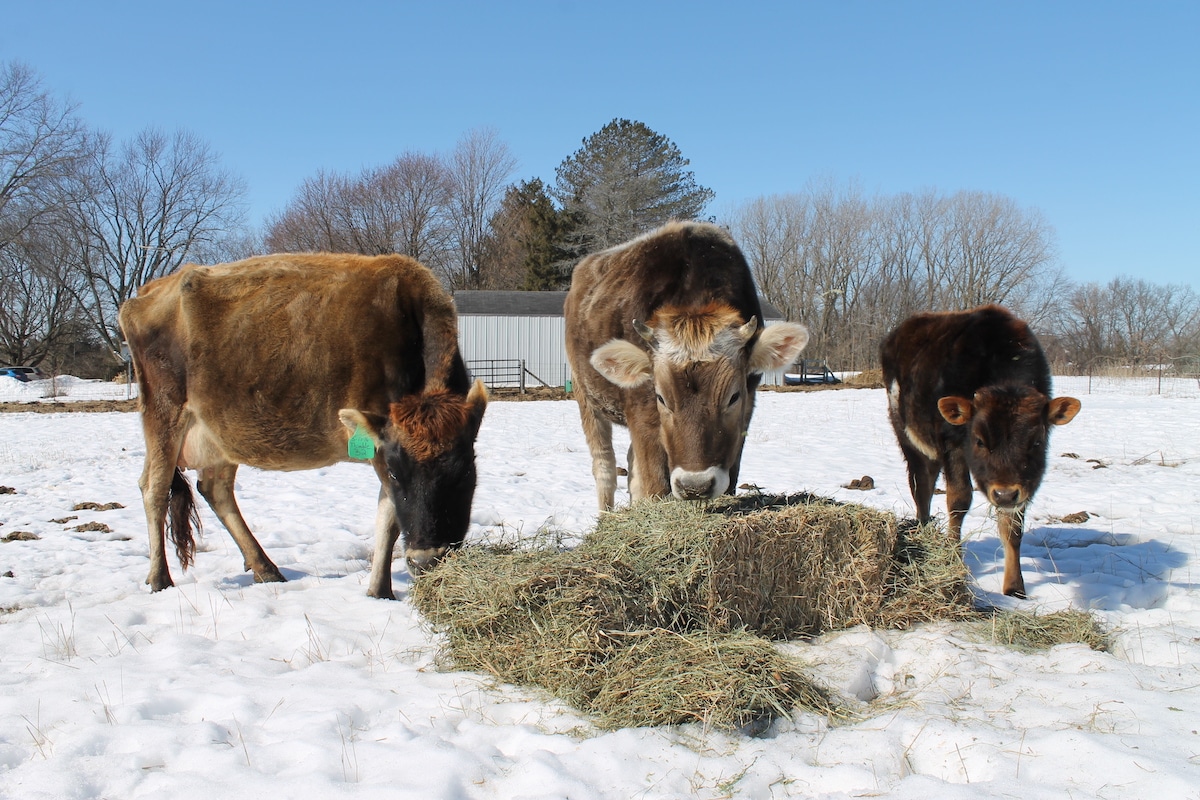
Cows can also be fed grains, or a combination of grains and hay. When hay or grains are in short supply, other supplements can be corn stalks, wheat straw, or soybean hulls. Alfalfa pellets or other protein supplements are also an option if their hay or feed is low in protein.
We feed our cows high-quality hay through the winter and have found that to be substantial for them.
Fresh Water and Minerals In Winter
Having constant access to a clean and unfrozen water supply for your cows is an absolute must!
There are two common options:
The most common is to add submersible or floating tank heaters to water tanks. We have a submersible heater with a 100-gallon stock tank that we currently use as a backup. It’s worked great when in use. The downfall of this setup is needing to run buckets of water out to fill it if you don’t have a frost-proof hydrant right next to it.
The second option is an automatic heated waterer that utilizes geothermal heat and/or a heater to stay unfrozen through the winter. There are many different manufacturers of automatic waterers, but we use a Jug—check out our full Jug Waterer Review. We absolutely love it and it is a lifesaver, especially in the winter months!
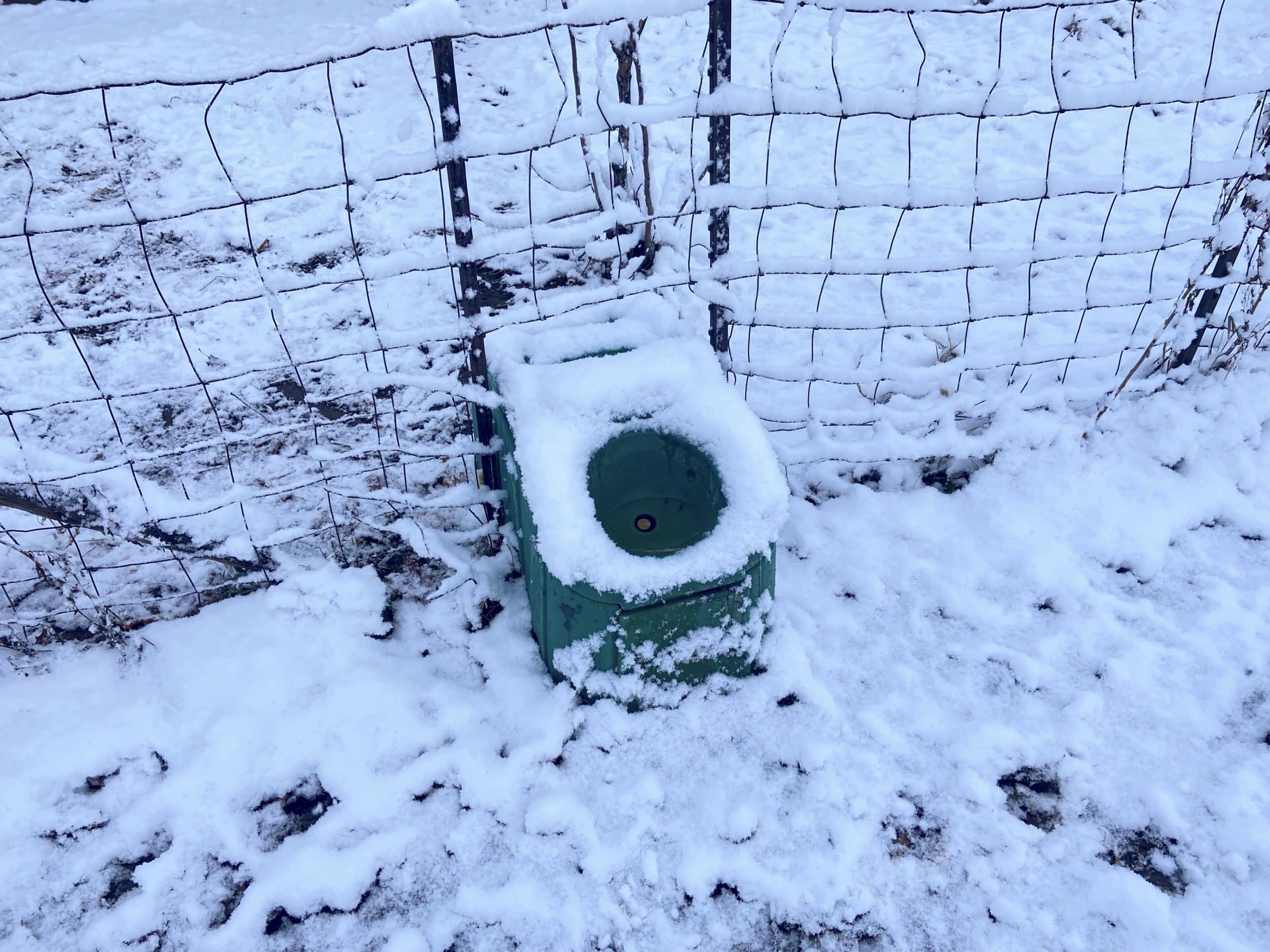
Salt and minerals are another big nutritional need that arises every winter. A cow’s nutrient requirements for minerals especially seem to spike when the cold sets in. So make sure you have a fresh supply of salt and minerals available to them.
We started out buying a salt block and mineral block from our local farm supply store. This worked fine, but we found it to be somewhat wasteful. Our small herd just couldn’t get through the blocks before they became spent and the cows wouldn’t touch them.
We now prefer a loose salt and mineral mixture called 10-Fine from Redmond Agriculture. We simply place a small scoop in a weighted rubber livestock bowl daily and they lick it clean without any waste.

Do cows need shelter in the winter?
The short answer is, “yes.” But not necessarily all the time. We have found that cows prefer to be outside when they can and so we try to reserve access to our barn shelter only when weather conditions turn extreme. That said, if you have a suitable barn setup, you can certainly give them as much access to it as you’d like.
Observation is your greatest tool when it comes to allowing your cows to have or not have access to a barn or other shelter. During the winter months, we keep a close eye on the weather and the cows themselves to know when it’s time to open up the barn for access.
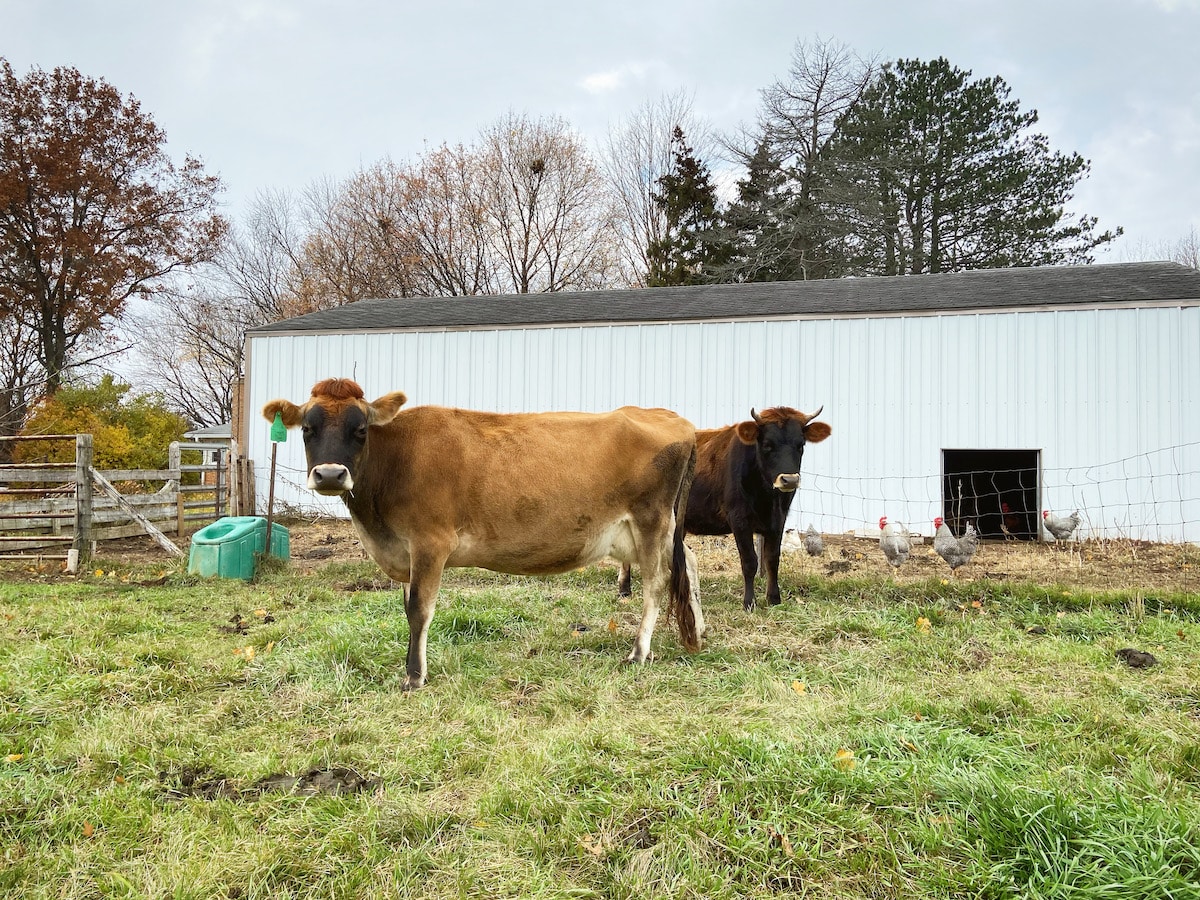
The other day the thermometer showed -2°F so we opened up the barn for our milk cow overnight. The next morning she greeted us outside for her morning milking, so we just milked her outside!
Winter cattle shelter requirements
Typically, a shelter with at least 3 sides and a roof is a minimum requirement for proper protection from wind and precipitation. Within the shelter, you’ll want to make sure the floor has dry bedding. We like to make sure to stock up on extra bedding in the winter months, the most common option being straw.
A stall inside a barn is ideal as a winter cattle shelter. Barns have a roof and can typically be closed up tight to keep out drafts and maintain heat. A simple lean-to structure is also commonly used with a roof overhead and at least three solid walls for the sides.

When in a pinch, a more basic approach might be to set up t-posts or fence posts and fasten pallets or plywood sheets to them to make a wind barrier. Trees or bushes can also help provide a wind barrier or shelter for animals in the winter months.
Where do cows sleep in the winter?
On still winter nights, cows will most likely choose to sleep beneath the stars like they would the rest of the year. On windy nights you’ll find them huddled up close to a windbreak to block the chilly wind. Or on wet nights they’ll likely seek out shelter and dry bedding to keep warm and dry.
As we’ve found out with our milk cow, they’ll often lay right in a warm pile of poop to keep warm! Cows just tend to be a little messier in the wintertime. So, if you have a milk cow especially, you may need to plan for a little extra time to clean them off.
Winter Cows Can Be Happy Cows!
So, yes, there are some extra things to think through and monitor in the winter. But your cows will be fine and dandy if you make sure their basic needs of food, water, and shelter are being met.
You don’t need pristine barns or an elaborate winter setup. Cows know how to keep themselves warm and stay happy and healthy all winter long!
Your management and care will play a vital role in that! Keep close watch on them. And keep close watch on the weather. Learn what helps them thrive over time and make adjustments quickly when you notice something is off.

What about you? What patterns have you noticed in your cows in the wintertime? Or, what have you found most helpful to let them survive and thrive through the cold winter months? We’d love to hear and learn from you!
To learn more about a family milk cow or keeping cows on your homestead, check out:
- Owning a Family Milk Cow Basics
- Simple Cow Milking Process For Beginners
- How Many Cows Per Acre On A Small Farm
- What To Know About Rotational Grazing On A Small Scale
- Calf Sharing – How to Add Flexibility to Your Homestead
- Breaking Down The Cost Of A Family Milk Cow
Pin it for later!
